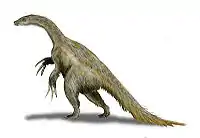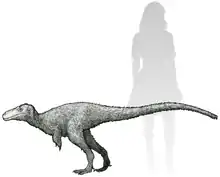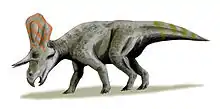Moreno Hill Formation
The Moreno Hill Formation is a geological formation in western New Mexico whose strata were deposited in the Late Cretaceous. Dinosaur remains are among the fossils that have been recovered from the formation.[1]
| Moreno Hill Formation Stratigraphic range: Turonian | |
|---|---|
| Type | Geological formation |
| Underlies | Fence Lake Formation |
| Overlies | Atarque Sandstone |
| Thickness | 217 meters (712 ft) |
| Lithology | |
| Primary | Sandstone, Shale |
| Other | Siltstone, Coal |
| Location | |
| Coordinates | 34.5893°N 108.7592°W |
| Region | |
| Country | |
| Type section | |
| Named for | Moreno Hill |
| Named by | McLellan, Haschke, Robinson, Carter, and Medlin |
| Year defined | 1983 |
 Moreno Hill Formation (the United States)  Moreno Hill Formation (New Mexico) | |
Description
The formation is a nonmarine coal-bearing formation composed mostly of sandstone and shale with minor siltstone. The shales are brownish gray in color, and the sandstones are discontinuous beds of very pale orange to light brown poorly sorted grains that usually show steep crossbedding. The sandstones are interpreted as channel or splay deposits in a fluvial environment. The shales include thin lenses of bituminous coal, including tonsteins (distinctive thin ash beds). The total maximum thickness is 217 meters (712 ft). It overlies the Atarque Sandstone and is in turn overlain by the Fence Lake Formation.[2]
The formation is laterally equivalent to the Tres Hermanos Formation, Pescado Tongue of the Mancos Shale, Gallup Sandstone, and lower Crevasse Canyon Formation. It represents beds southwest of the pinchout of the Pescado Tongue where the Tres Hermanos Formation and Gallup Sandstone are no longer lithologically distinguishable.
Vertebrate paleofauna
The Moreno Hill Formation was originally thought to be devoid of fossils,[2] but it has since yielded a diverse vertebrate paleofauna.
Fish
| Dinosaurs of the Moreno Hill Formation | |||
|---|---|---|---|
| Taxa | Presence | Description | |
|
Genus:
|
An Amiid or basal ray-finned fish | ||
Dinosaurs
| Dinosaurs of the Moreno Hill Formation | ||||
|---|---|---|---|---|
| Taxa | Presence | Description | Images | |
|
Genus:
|
A basal hadrosauromorph.[3] |
| ||
|
Genus:
|
A therizinosaur.[4] "Teeth, fragmentary skull bones, cervical and other vertebrae, scapula, partial forelimb and hindlimb."[5] | |||
|
Genus
|
A tyrannosauroid based on a partial skull and skeleton.[6] | |||
|
Genus:
|
A ceratopsian.[7] "Partial cranial and postcranial materials of five individuals."[8] | |||
|
Clade
|
||||
History of investigation
The formation was first named by McLellan et al. in 1983 for exposures around Moreno Hill in the Salt Lake coal field of western New Mexico. The beds were originally mapped as Mesaverde Group, but were recognized to be much lower in the stratigraphic column.[2]
See also
- List of dinosaur-bearing rock formations
References
- Weishampel, David B; et al. (2004). "Dinosaur distribution (Late Cretaceous, North America)." In: Weishampel, David B.; Dodson, Peter; and Osmólska, Halszka (eds.): The Dinosauria, 2nd, Berkeley: University of California Press. Pp. 574-588. ISBN 0-520-24209-2.
- McLellan, M.W.; Haschke, L.R.; Robinson, L.N.; Carter, M.D.; Medlin, A.L. (1983). "Middle Turonian and younger Cretaceous rocks, northern Salt Lake coal field, Cibola and Catron Counties, New Mexico" (PDF). New Mexico Bureau of Mines and Mineral Resources Circular. 185: 41–47. Retrieved 16 September 2020.
- McDonald, A.T.; Wolfe, D.G.; Kirkland, J.I. (2006). "On a hadrosauromorph (Dinosauria: Onithopoda) from the Moreno Hill Formation (Cretaceous, Turonian) of New Mexico". New Mexico Museum of Natural History and Science Bulletin. 35: 277–280. Retrieved 16 September 2020.
- J.I., Kirkland; Wolfe, D.G. (2001). "First definitive therizinosaurid (Dinosauria: Theropoda) from North America". Journal of Vertebrate Paleontology. 21 (3): 410–414. doi:10.1671/0272-4634(2001)021[0410:FDTDTF]2.0.CO;2.
- "Table 7.1," in Weishampel, et al. (2004). Page 152.
- Nesbitt, Sterling J.; Denton, Robert K.; Loewen, Mark A.; Brusatte, Stephen L.; Smith, Nathan D.; Turner, Alan H.; Kirkland, James I.; McDonald, Andrew T.; Wolfe, Douglas G. (June 2019). "A mid-Cretaceous tyrannosauroid and the origin of North American end-Cretaceous dinosaur assemblages". Nature Ecology & Evolution. 3 (6): 892–899. doi:10.1038/s41559-019-0888-0.
- Wolfe, D.G; Kirkland, J.I. (1998). "Zuniceratops christopheri n. gen. & n. sp., a ceratopsian dinosaur from the Moreno Hill Formation (Cretaceous, Turonian) of west-central New Mexico". New Mexico Museum of Natural History and Science, Bulletin. 14: 303–317. Retrieved 16 September 2020.
- "Table 22.1," in Weishampel, et al. (2004). Page 480.
- Sterling J. Nesbitt; Robert K. Denton Jr; Mark A. Loewen; Stephen L. Brusatte; Nathan D. Smith; Alan H. Turner; James I. Kirkland; Andrew T. McDonald; Douglas G. Wolfe (2019). "Supplementary information for: A mid-Cretaceous tyrannosauroid and the origin of North American end-Cretaceous dinosaur assemblages" (PDF). Nature Ecology & Evolution. 3 (6): 892–899. doi:10.1038/s41559-019-0888-0. PMID 31061476.



